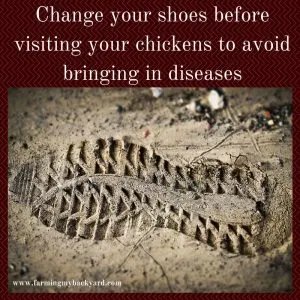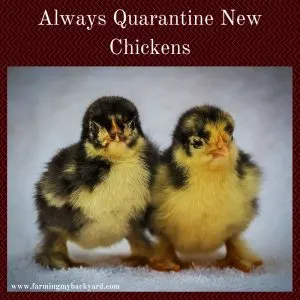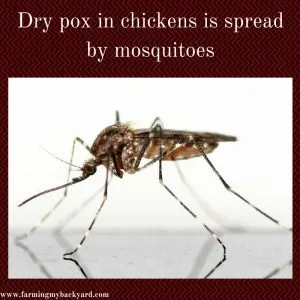One of the best things about small residential flocks of chickens is that they tend to be exceptionally healthy. Many of the chicken diseases that affect larger commercial flocks are just not a big deal for small backyard homesteaders.
However, there are a few chicken diseases you should be aware of, just in case. Some of them are signs of problems with your management practices.
Some of them are not preventable at all, but can be treated. Others indicate that you’d be better off starting over with new, healthier birds.
For more information regarding chicken health, please check out these related posts:
- Deworming Chickens: Do You Need To Worry About it?
- Be Ruthless With Chicken Mites and Other Obnoxious Bugs
- How Do You Know If You Have a Sick Chicken
- How To Clean Your Chicken Coop The Right Way
Or get all our chicken wellness resources in one easy to read source and check out our book, Backyard Chickens: How To Have A Happy Flock!
Here are some chicken diseases you need to know about:

These chicken diseases can be caused by bacteria, protozoa, or viruses. Some you can prevent with management practices, and others there is very little you can do. All of them are common among poultry in the United States.
You may never notice a problem in a small backyard flock, but it’s good to be familiar with the potential issues, and to have an idea how to handle them if they pop up.
If you are very concerned about the wellness of your flock, I highly recommend the book, The Chicken Health Handbook by Gail Damerow.
It’s detailed and informative, and includes great information on how to administer vaccines yourself, and has loads of information not only on disease, but also the different medications available, as well as general chicken wellness.
If you want more chicken book recommendations, check out our resource page.
Air Sac Disease
Air sac disease is a respiratory disease like CRD, but usually occurs in chicks about 6-9 weeks old, instead of adult birds.
Signs of Air Sac Disease
It can be caused either by E. coli bacteria or mycolpasma gallisepticum. The symptoms are weight loss, coughing, nasal discharge, watery eyes and difficulty breathing.
It can also cause weight loss and a loss of appetite, which in turn causes uneven growth of the chicks.
Managing Air Sac Disease
Try to avoid dusty litters and make sure the chicks have good ventilation. Also avoid letting them get chilled.
If your birds do get infected, make sure they stay warm and feed them a high protein feed with plenty of vitamin E, which is found in sunflower seeds.
Be aware, however, that the survivors will now be carriers and can potentially infect other birds in the future.

Arthritis
Arthritis is not contagious, however it comes from a staph infection where the bacteria has settled into the chicken’s joints.
The chicken either gets a staph infection from drinking out of muddy puddles, or when bacteria enters through a wound.
Signs of Arthritis
The exact symptoms will vary depending on which location of the body the bacteria are in. Generally their joints will be feel hot and swollen.
The chicken may limp and lose weight. Also, it may move so much less that it develops breast blisters.
Managing Arthritis
You can help stave off staph infections by avoiding crowding, and keeping the run clean and dry.
The staph infection may be treatable with antibiotics as long as you do lab testing to find out which specific strain of staph to treat.
Avian Influenza
Remember when everyone was afraid of the bird flu? Well, actually avian influenza has actually been around for centuries. Usually it’s very mild and causes no signs in the chickens.
Sometimes it evolves into a more dangerous strain when it’s among a concentrated number of confined chickens. (One more reason to keep a small backyard flock instead of eating commercially).
Signs of Avian Influenza
With the more deadly strain, often the first symptom is death. However, it is more likely that you will notice symptoms such as coughing, sneezing, diarrhea, a drop in laying, or even a twisted neck or paralyzed wing.
Managing Avian Influenza
Avian influenza is spread through infected droppings, as well as secretions from the eyes, mouth, and nose.
Practice good bio-security with your flock, such as not spreading disease on the bottom of your shoes from flock to flock.

Avian Tuberculosis
Your chances of having a bird with Avian Tuberculosis increase if you keep your laying hens as pets. But don’t worry, it’s not the same strain that infects humans.
Chickens get it from picking at soil, feed or water from the droppings of infected birds. It takes a long time to develop, so if you frequently replace your laying flock with younger birds you may never see it.
Signs Of Avian Tuberculosis
A bird with this infection will lose weight even while eating well. It may die quickly, or it could take even years.
Managing Avian Tuberculosis
Unfortunately there is no treatment for already infected birds. If this is already a problem in your flock your best option is starting completely over with a new flock in a new location.
Breast Blister
Breast blisters are most commonly issues with the Cornish Cross breeds of meat birds. However, they can also become issue for chickens with arthritis who are reluctant to move around much, or when chickens are raised on wire or hard, packed dirt.
Signs of Breast Blisters
Breast blisters are pretty much as they sound, fluid filled blisters along the breast bone of a chicken. If the fluid is clear, it may resolve itself on its own.
Managing Breast Blisters
Keeping your birds on grass or soft bedding should discourage blisters from forming. If you notice an infected breast blister, the fluid inside will become yellow or cheese-like.
If it does become infected you will need to determine the underlying cause of infection (such as staph) and treat for that.
Blackhead
Blackhead is cause by a protozoa, which is spread by worms in the chickens droppings. It’s mainly an issue with turkeys, but chickens with depressed immunity can be infected, and all chickens can be carriers of it.
Signs of Blackhead
The symptoms of Blackhead include listlessness, droopy wings, and pale comb. The chickens may also have a loss of appetite, weight loss, or stunted growth. Bloody or sulpher colored droppings are also an indication.
Managing Blackhead
To manage Blackhead, avoid housing chickens and turkeys together. Also treat your chickens for worms as necessary. and keep their living quarters as dry and not muddy as possible.
Bumblefoot
Bumblefoot is a staph infection in the foot. Chickens can get it from scratching in rocks or gravel, rough, splintery bedding, or from living on concrete or hardware cloth.

Signs of Bumblefoot
The chicken may limp, or avoid walking, and when you look closer there is a black scab on the bottom of their foot, along with a lump.
Managing Bumblefoot
If the lump on the bottom of the foot is soft you may be able to treat the abscess by cleaning the foot, injecting antibiotics and moving the chicken to a clean place.
If the lump is hard, it will need the hardened core removed. A vet can do this, or you can do it yourself.
If you do not have a vet available, I suggest following the directions in The Chicken Health Handbook.
Chronic Respiratory Disease
CRD is caused by mycoplasma bacteria. It is one of the causes of decreased laying. It comes on slowly, affecting older birds. Once infected, chickens are immune from getting it again, but they can affect other chickens.
Signs of Chronic Respiratory Disease
The first sign of CRD is weeping and swelling in the eyes. this can be treated with an eye ointment (see The Chicken Health Handbook for instructions).
Without treatment the eyes can get stuck shut. You may also notice the chicken gasping for air and producing discharge from the nose.
Managing Chronic Respiratory Disease
To prevent CRD in your flock, make sure your birds have plenty of ventilation. Also limit their exposure to cold temperatures. Limit contact with sick birds, and properly quarantine any new birds you bring into the flock.

Coccidiosis
Coccidiosis is caused by a protozoa, and is the most likely cause of death for young birds, especially around 3-6 weeks old. The protozoa live in the intestines of almost all birds, but gradual exposure builds up their immunity.
Infection is common around 3 weeks old because it has built up in the brooder faster than the bird’s immunity. There are however several different species, so when you bring birds from different sources together, they can cross infect each other with strains they are not immune to.
Infections can also happen because of poor cleanliness, or if the chicken’s immune system is suppressed by stress.
Signs of Coccidiosis
Symptoms of cocci include decreased appetite in chicks, slow growth, runny or off color droppings, bloody droppings, or dehydration. Infection in older pullets can cause slow or no egg production, and pale skin on the legs and comb.
Managing Cocci
The best way to manage cocci is to help chicks build up exposure slowly. If you keep them on wire they may not get any immunity at all!
Some flocksters have had good success composting old chick litter and reuising it with fresh bedding to balance the microbes that discourage cocci.
Alternatively, raising birds on a pasture system works well because you can rotate them to fresh grass.
Other ways to discourage cocci in the brooder is to keep the feeders and waterers clean and filled, so as to discourage the chicks from pecking at any droppings.
One tablespoon of vinegar per gallon of water will also discourage the protozoa from multiplying.
Dry Pox
Dry pox is NOT the same as chicken pox in humans. It is fairly mild, and usually resolves by itself. (It’s not common relative, wet pox can be much more serious).
Signs of Dry Pox
Dry pox causes wart like bumps on the chickens skin. You may notice them on the comb or wattles, or even their feet and legs. They form scabs, which fall off, and the chicken usually recovers in 4-5 weeks.
Managing Dry Pox
It is spread by wounds, such as fighting, or insect bites such as mosquitoes. Keeping mosquito and other biting bugs down will help.
There is also a vaccination available, which may be a good idea if you show your chickens, or if your area has a bad mosquito problem.

If you notice a bird with the sores, keep her by herself until she recovers. You can add vinegar to the drinking water to help discourage it from spreading, and once everyone is recovered, clean and disinfect everything.
Egg Peritonitis
Egg peritonitis is caused by E. coli bacteria in the hen’s oviduct. The infection occurs in the oviduct, which causes the chicken to stop laying. The materials coalesce inside the hen until finally they spill into her body cavity.
Signs of Egg Peritonitis
The hen will have a swollen abdomen, and keeps her back end lowered to the ground when standing or walking. Eventually she dies.
Managing Egg Periotonitis
Prevention is reducing the hen’s exposure to E. coli. make sure they have good ventilation, and clean litter. Using nipple waterers or cleaning their waterer frequently will also help.
Feeding hens probiotics, such as yogurt with live cultures will also help prevent infection.

Fowl Cholera
Fowl Cholera is caused by the pasturella bacteria. There are two forms, chronic, and acute, and older birds are more likely to become affected.
Signs of Fowl Cholera
In an acute infection, the only sign you may have is a chicken that suddenly drops dead. Alternatively you may notice lethargy, loss of appetite, weight loss, and mucus coming from the chicken’s mouth.
In a chronic infection the bacteria settles into part of the body and causes local symptoms such as swelling of the joints or around the eyes, or a twisted neck.
Managing Fowl Cholera
Fowl Cholera is spread through the mucus, although the bacteria lives in the ground for up to 3 months and can be spread on the bottom of shoes.
The best way to manage it is by not mixing different ages of birds, or birds coming from different flocks, as apparently healthy birds can still be carriers.
Infectious Bronchitis
Infectious bronchitis is a highly contagious respiratory disease. It can be more obvious in chicks, but older birds will have a rattling noise in the throat when they are on the roost at night.
Once they get it, birds will be temporarily immune, but they will not lay as well as birds who were never infected.
Signs of Infectious Bronchitis
Chicks will cough, sneeze, and have rattling sounds in the throat. Symptoms are less noticeable in older birds, but you may notice them at night. Chicks may even die.
Managing Infectious Bronchitis
There is a vaccine available, but it is not successful against all strains. If infectious bronchitis has become an big problem in your flock, the best way to handle it is put all the birds down, disinfect, and start over with a fresh flock.
Infectious Bursal Disease
Infectious bursal disease is cause by a virus in the lymph tissue, and is sometimes also called Gumboro Disease.
Sometimes chicks can be born with maternal antibodies, which makes it difficult to tell if they have been infected, because they have no symptoms. It can be easier to spot in chicks from 3-6 weeks old.
Signs of Infectious Bursal Disease
The first sign is white diarrhea that stains the vent feathers. You may also notice lethargy, reduced appetite. Your birds may have a wobble when they walk, or be reluctant to even stand at all. Infected birds will either die, or recover.
Managing Infectious Bursal Disease
There is a vaccine, but it’s not very widely used. It can be difficult to get rid of in your chicken housing, but chicks that are exposed to it when young have a natural immunity. Once exposed birds are NOT carriers, but can pass on their immunity to their own chicks.
Infectious Coryza
Infectious Coryza is the equivalent of a chicken cold, and is spread the same way, by droplets propelled by coughing and sneezing.
Signs of Infectious Coryza
This looks like a respiratory infection, so it may be hard to pinpoint what specifically is the cause. Your chicken will have nasal discharge, sticky eyes, or a swollen face.
Managing Infectious Coryza
There is a vaccine but it must be redone every two years, so it’s best to use it only after you know your flock has had an outbreak.
Alternatively, you can start over with a new flock. Dispose of the sick birds, and thoroughly clean everything. Leave it vacant for at least three weeks before bringing in new birds.
Laryngotracheitis
This is a relative of the herpes family that causes an upper respiratory infection in the larynx. (Betcha didn’t guess that! Just kidding…). Most often it is mild though.
Signs of Laryngotracheitis
Birds that are infected will have watery eyes that turns yellow and crusty. The chickens may cough, sneeze, or even stretch their necks out while breathing or shake their heads.
Managing Laryngotracheitis
Because there are no treatments, and any birds that survive can infect new birds in the flock, it’s probably best to start over with a fresh flock.
If you do this, thoroughly cleaning the chicken coop and yard, then waiting two months should keep your new flock from getting infected.
Alternatively, if you choose to keep previously infected birds, you may want to vaccinate any new flock members you add later.
Lymphoid Leukosis
It’s a good bet that your chickens probably have lymphoid leukosis, even if they have no signs of it. It is caused by a retrovirus, and is mainly spread through the egg, although it can be spread by droppings and insects such as mosquitoes.
Signs of Lymphoid Leukosis
It causes tumors, and often looks like Marek’s disease, with leg paralysis. Symptoms are most common in birds that are just reaching laying age.
Managing Lymphoid Leukosis
Unfortunately there is no treatment, or vaccine, and it can be deadly for the birds. Any that do survive are carriers. You can see now why it’s so prevalent. 🙁
Marek’s Disease
Marek’s disease is caused by a herpesvirus, and it is also so common that virtually all chickens have it, even though it may be dormant.
Signs of Marek’s Disease
The signs can vary widely, depending on the form it is, but a common symptom is leg paralysis. You will see young chickens with one leg stretched forward and the other back behind itself.
Managing Marek’s Disease
There is a vaccine available, and most hatcheries offer vaccinated chicks. It’s not a hundred percent effective, and the birds may still infect other birds, especially if they are stressed or their immune system is not in tip-top shape.
There are some chicken breeds that seem more resistant however. Hooray! If you keep your own breeding flock, you can always breed for disease resistance.
Newcastle Disease
There are several strains of Newcastle Disease, some that are more severe, and one that is fairly mild. Thankfully, the more severe strains are not very common. The mild strain is highly common and can cause respiratory problems and an infection of the intestines.
Signs of Newcastle Disease
The indications that you will most likely see in your own flock are coughing and gasping, or occasionally nerve problems such as wing paralysis. You may not even be able to distinguish if from other respiratory problems.
Managing Newcastle Disease
Most chickens will recover on their own, without ill effect.
Omphalitis
Omphalitis is also known as Mushy Chick Disease. It’s an infection in chicks that occurs after the egg sack isn’t absorbed. It causes chicks to die for up to two weeks after hatch. It’s caused by bacteria either in the egg when formed, or that gets through the shell.
Signs of Omphalitis
The chicks affected will have soft bodies and a swollen blue abdomen. Their naval is also unhealed.
Managing Omphalitis
Once affected, you may try cleaning the chicks’ naval several times a day with iodine. Feeding them extra vitamin E may also help. (Sunflower seeds are high in vitamin E).
To prevent it from occuring make sure your incubator is properly sanitized and ventilated. During incubation keep the temperature high enough and the make sure the humidity doesn’t get too high.
Paratyphoid
Unfortunately, Paratyphoid is caused by Salmonella bacteria, the same strain that can also make humans sick. Up to 75 percent of chickens are infected with salmonella, and even the healthy ones can be carriers.
It can be transmitted through the yolk and shell to chicks. It can also be spread by contaminated droppings, drinking water, rodents, even on your own shoes!
Signs of Paratyphoid
Indicators of an active infection is chicks dead in their shells, or chicks with very little appetite, but increased thirst and diarrhea with vent pasting. Chickens who are carriers can have no symptoms, but still spread the bacteria.
Managing Paratyphoid
It can be difficult to manage paratyphoid because is is so easily spread. If you have infected birds, it’s best to start fresh with a new flock. Fortunately, a hot compost will kill the bacteria in old chicken litter.
Keep your chicken yard and hen house as clean as possible, and having good flock bio-security can help. (I.E. try not to track bacteria in from other flocks in on your shoes).
Toxoplasmosis
You may have heard toxoplasmosis in relation to cats and pregnant women, namely that pregnant women shouldn’t clean litter boxes in case they contract toxoplasmosis, which can be harmful to the unborn child.
Signs of Toxoplasmosis
Chickens don’t get it themselves, but they can be an intermediate host, which means if you eat undercooked meat from an infected chicken you could get it yourself.
Managing Toxoplasmosis
It’s not a big deal (unless you’re pregnant), but to be on the safe side, keep your chicken yard dry, and clean of cat feces. Also, don’t feed yourself or your cats undercooked chicken.
Hopefully you never need to deal with the disease in this post! But just in case, it’s good to be prepared and know what actions you will need to take. Has your backyard flock been sick? Share in the comments below!
Sources:
Common Poultry Diseases by University of Florida Extension
The Poultry Site Quick Disease Guide
The Chicken Health Handbook by Gail Damerow
The Small-Scale Poultry Flock by Harvey Ussery
Want To Raise Happy Chickens?
Subscribe for our newsletter and get the free email course Intro To Backyard Chickens as well as a free printable checklist to walk you through step by step!

Bryana
Saturday 15th of April 2023
Hi :)) I have a chicken who normally lays brown eggs but lately her eggs are super pale or white and the weird part is that they're thin, but I give her a good source of calcium everyday. Also I've noticed that she's pooping very little and its sometimes water green or mostly white. She also doesn't seem to have much of an appetite either and she's all fluffed up and looks depressed just not her regular behavior. Her comb is not pale at all its still a bright red she hasn't been sneezing or coughing and no mucus, and her feet are perfectly fine. Im trying to figure out what's wrong with her to be able to cure it fast and I'll really appreciate your help. Thank you.
Bryana
Saturday 15th of April 2023
@Bryana, I also don't believe it has to do with old age considering that she's barely going to turn 3 this year.
Natalie Slack
Sunday 1st of August 2021
Hey there,
I was wondering if you'd be able to help me. I have a sick chicken (fluffed up, moving around slowly, still eating and drinking but not as much as usual, droppings slightly watery) but otherwise physically okay, nothing wrong with her eyes, comb, legs, etc. What do you think this could be? She's about 4 and a half, I'm thinking maybe I need to worm my flock or treat her for Cocci? I've been reading about her symptoms but there's nothing specific standing out. It has been about 5 days and we checked her for being eye bound but doesn't seem to be the case. She is slightly waddling with her tail down but is still talking and going to her coop with the others at night. Any help would be greatly appreciated. Thanks so much!
Kathryn
Monday 2nd of August 2021
With chickens it's so hard to know. Definitely check for worms just in case. At four years old, depending on the breed, she may just be slowing down with age.
Natalie Slack
Sunday 1st of August 2021
@Natalie Slack, egg** bound.
LuLu
Wednesday 12th of May 2021
My 4-year-old hen Rose has grayish-olive green diarrhea. She is very hungry, very thirsty and no longer lays eggs. She is a New Hampshire Red. I have put different additives in a second waterer (singly, different each day and separate waterer with just plain water): probiotics, electrolytes, apple cider vinegar, oregano oil powder, B-12, Poultry Cell. I have added Omegas to mash. She eats and drinks alot. She will forage with the flock but tends to go back to the run for food. Any ideas what is going on, what I can do for her?
Kathryn
Saturday 15th of May 2021
Hmmmm, I would maybe try deworming? Also, if adding supplements to water, go ahead and stick with one for a few days at a time and have it be in the only water available.
Buck Williams
Saturday 20th of March 2021
I found one of my chickens dead this morning after I had observed that she was very sluggish for the last two days. She was still eating although not being very social, she was part of my flock of eight and I have not had any health issues with them, they have been together here for about a year. After reading your posts here, I suspect fowl cholera, my question is, what do I need to do for the rest of the flock, or am I overlooking something else?
Kathryn
Saturday 20th of March 2021
Unfortunately the symptoms could mean a number of different things. It's probably a good idea to clean and sanitize as much as possible, and make sure your coop has good ventilation.
nicola Rands
Monday 8th of March 2021
Hi, I have 7 chickens and 2 of them have a bare bottom. Doesn’t look sore. They all seem happy and no change in diet. Then today I found one dead and an egg with a little blood on. Is it connected to the feather loss, or do you think she was pecked to death by the others because of the blood?
Kathryn
Monday 8th of March 2021
I would look closely for signs of mites on your birds or on their roost at night.